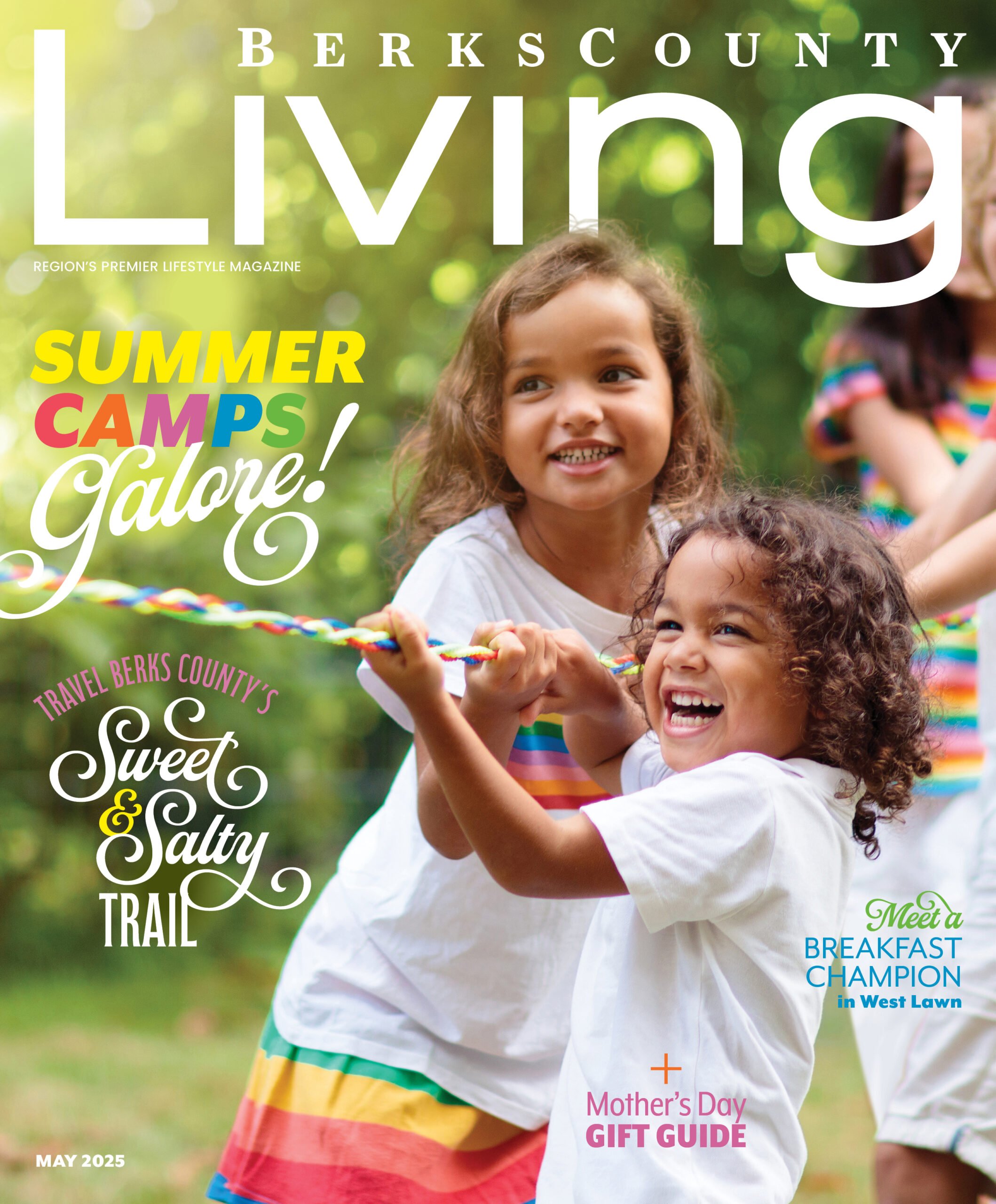They’ve got spirit, yes, they do. Each of Berks County’s higher education institutions says it loud and proud. The staff, faculty and students are unique, but united in their pride for their campuses.
KUTZTOWN UNIVERSITY
Kutztown University’s Golden Bear faculty, staff and students know it’s good to be golden, but now they know it more than ever, thanks to a recent rebranding effort.
It really started five years ago, explains Assistant Vice President of Communications, Marketing and External Affairs John Green. “That’s when, nationwide, competition for enrollment started and we began to see a drop off,” he explains. It was then that it became glaringly obvious: KU needed to shine a light on what makes it special.
Help from (Hired) Friends, Staff & More
Being that the University’s marketing department consists of Director of Marketing Jennifer Umberger plus one, it was an enormous task to consider tackling internally. After a nationwide search, KU hired Ologie, a branding agency based in Columbus, Ohio. Explains Green, “Their work is just shy of brilliant.”
What did they – with the help of a Brand Champions committee consisting of staff, faculty and student advisors – discover?
“The students, faculty and staff at Kutztown are very welcoming, genuine and hard working. The University truly values character and work ethic and is dedicated to helping students grow into their best selves. The combination of all of these attributes is what makes Kutztown, Kutztown,” asserts Sierra Swanson, associate creative director for Ologie.
Market research also showed the campus to be a humble one. “That [humble] nature is part of what kept our ‘best kept secret,’” explains Green of the need for KU’s supporters to share their pride more publicly.
Who They Are
Once Ologie helped the Brand Champions discover the essence of Kutztown University, it was time to sum it all up in a succinct, sharable message.A story. Who is a Golden Bear?
We’re all works in progress. Whether you know exactly what you want to do or you’re stilldeciding, this is your time toexplore. To try, to fail, and to go places you never thought possible. And you’ll never do it alone. We believe in having each other’s backs. That creating a strong community empowers individual freedom. And that with the right support, resources, and challenges, you’ll grow, not into someone new, but into yourself. Because at your best, there’s no limit to what you can do.
It’s good to be golden.
The Heartbeat of KU
The message is spreading like wildfire on campus. And different groups are enthusiastic for different reasons.
For Communications Studies major Jacob Sims, a member of the Brand Champions focus group, it’s something he believes students will find confidence in. He explains, “I think it will bring a lot more school pride to the student population by creating a message that can resonate on a personal level. KU has opened so many opportunities in academics and leadership for students across campus, and this rebranding can help put into words how KU has helped all of us.”
The pride has certainly been carried in the hearts of faculty and staff for some time, as evidenced by the two consecutive wins in the Mascot Madness Competition by KU’s own Avalanche the Golden Bear, who made his campus debut in 2005.
Now, aimed with a succinct message summing up the essence of what it means to be part of the university family, KU students, faculty, staff and alumni can proclaim proudly, “Here you Roar.”
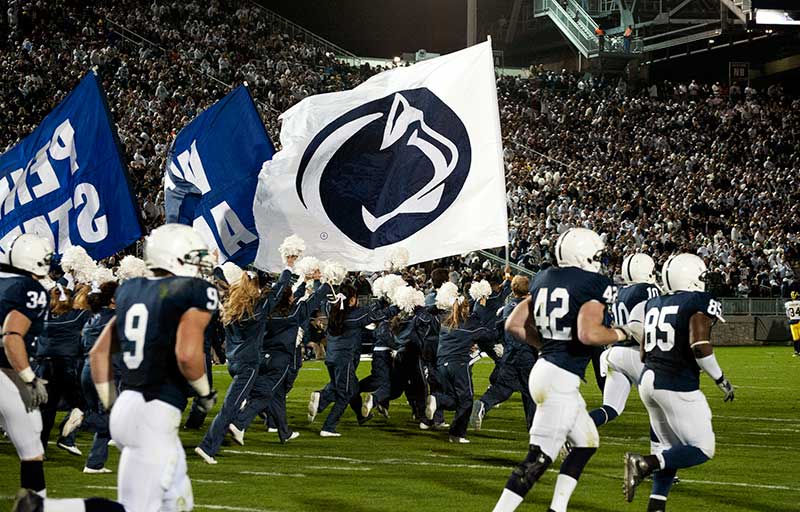
PENN STATE BERKS
If you’re a Penn Stater and you travel anywhere in the world and shout “We are” in a crowd of people, there’s a pretty good chance you might hear “Penn State” from a fellow Nittany Lion.
The words hearken back to the now-famous football players who made history in 1946 when they refused to play the segregated University of Miami. The account goes that when told they must leave their black players at home, the team voted unanimously to cancel the game. The following season, the question rose again, and lineman Steve Suhey said, “We are Penn State,” adding that there would be no need for further discussion. The entire 1947-48 team went on to play Southern Methodist University in the Cotton Bowl in a game that would become symbolic of desegregation in athletics.
The phrase “We Are… Penn State” has become part of the fabric of the University itself. The origin of the chant, as we know it today, started with the cheerleaders of the late 1970s, who were looking for a way to engage the crowds in Beaver Stadium and tirelessly cheered “We are!” for years until the phrase caught fire in the early 1980s –and it hasn’t slowed since.
“We Are… Penn State” has become the battle cry for students, faculty, staff and alumni across the University and its 24 campuses. While Penn Staters come from diverse backgrounds and ethnicities, they are all connected by a sense of pride.
At Penn State Berks, the “We Are…Penn State” mantra signifies that students, staff and faculty are part of one of the most well renowned, global research universities in the world. Students have a multitude of options; they can choose among the 20 baccalaureate degrees offered by the college or complete the first two years of more than 160 degree programs at other Penn State campuses. Either way, students graduate with a Penn State University degree.
Penn State Berks offers students all the benefits of a major research university with smaller class sizes and personalized attention. The close-knit community and beautiful 258-acre campus provide an inviting atmosphere that makes students feel at home. Many choose to remain at the college for all four years due to the wide variety of opportunities they have and the close personal relationships they form.
Beyond the classroom, students have the opportunity to get involved in undergraduate research, internships, study abroad and many other activities. Community service is also a fundamental part of the Penn State experience. Students have volunteered with many local organizations including Opportunity House, Olivet Boys and Girls Club, and Habitat for Humanity.
When students graduate, they join a prestigious group of more than 650,000 Penn State alumni worldwide. The Penn State Alumni Association is one of the largest alumni associations in the world. A Penn State degree opens the door to a world of possibilities.
Pride has always been an integral part of the Penn State story. Our rallying cry can be heard around the world…We Are Penn State!
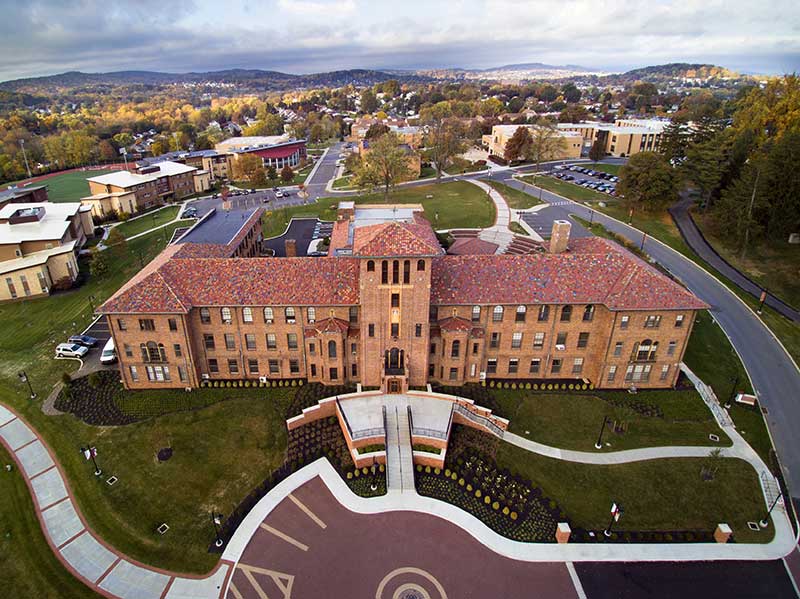
ALVERNIA
Since 1958, Alvernia University has been dedicated to developing successful professionals who become engaged citizens with moral courage.
A Distinctive Franciscan University
One of only 24 Franciscan institutions in the country, Alvernia was founded by members of the Bernardine Franciscan Sisters, who emigrated to Pennsylvania more than 100 years ago. Today, the Sisters’ rich heritage of service and their ideal of “knowledge joined with love” resonate throughout campus life, academics and extracurricular programs. The idea, explains Jay Worrall, director of the university’s Holleran Center for Community and Global Engagement, “is to provide an unparalleled environment for our students to grow into what we call ethical leaders with moral courage, essentially agents for positive change in the community.”
Service in the Real World
Long before Alvernia’s nationally recognized Holleran Center began guiding students though 30,000 hours of service each year, engaging with the community was the very heartbeat of the University. Celebrating its 10th anniversary this year, the Holleran Center has grown to become the home for all real-world learning opportunities available to students — from campus-based leadership programs to global study, from service trips to professional field placements, from community-based research projects to internships and career planning workshops.
The University’s Real World Learning Awards (over and above regular financial aid) help finance long distance internship and service opportunities as well as academic study in places like China, the Dominican Republic, Italy, Spain and Ireland. Nearly 50 Alvernia students took advantage of these special funds last year.
“Opportunities like these give students valuable job experience, while planting seeds of social awareness in their hearts,” says Worrall. “We want the Alvernia experience to be transformational — to help each student turn what they love into a lifetime of career success and personal fulfillment.”
Impacting Poverty though Education
One truly ambitious initiative at Alvernia is the Reading Collegiate Scholars Program. The program seeks to make Alvernia’s private, values-based collegiate experience possible for inner-city students from Reading. Though it provides full scholarships, the program is much more than financial in nature. Its college readiness and mentoring program has already helped hundreds of Reading students navigate paths to colleges of their choice — and students who choose Alvernia benefit from a comprehensive college success program that helps them stay on track academically, while also planning for the future through key professional community connections.
The program provides a solid bridge for underprivileged students, empowering them to thrive and graduate from college — and to become successful professionals who will return to be committed servant-leaders in the community.
Alvernia is actively seeking local businesses and donors to invest in the City of Reading’s future though this groundbreaking program. “This is a significant commitment for Alvernia, but the potential to change lives is even more significant,” says Alvernia President Thomas F. Flynn, Ph.D., “and the return on investment for our community is, frankly, unmatchable.”
Bolstering Health Services
A different kind of investment that Alvernia is making into Greater Reading’s community is through expanding its popular Doctor of Physical Therapy program and other successful health science offerings to fill gaps in Reading and Berks County’s professional health services fields. Importantly, although only 25 percent of Alvernia freshmen hail from Berks, a much larger number — almost 40 percent of the University’s alumni — remain afterwards to live and work locally. Many of these graduates fill important roles in healthcare, education and the business community.
With this in mind, a new recreation, wellness and health sciences complex, called the PLEX, is planned for the university’s East Campus. In addition to generations of healthcare professionals who will benefit from the facility, local high school athletes, athletic clubs and residents will have access to the PLEX’s indoor track and athletic facilities.
Alumni Action
Instilled with a spirit of service, Alvernia students continue to graduate as women and men of conscience and compassion, as well as competence. So it should be unsurprising that 75 percent of the University’s alumni continue to volunteer in a variety of capacities after graduation. “As I challenge our new students at Freshman Orientation and our seniors on their graduation day, we expect our students and alumni “to do well and to do good,” says Flynn.
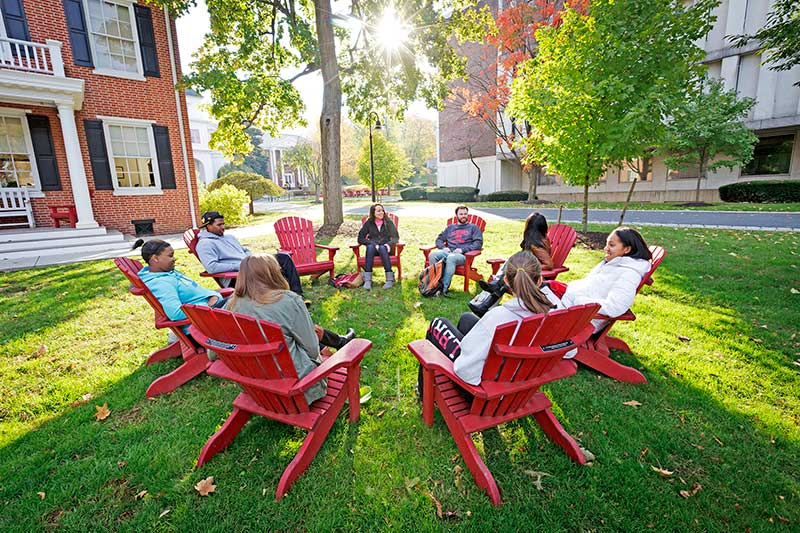
ALBRIGHT
A pride of lions…or, at Albright College, the Pride of Lions.
After all, Albright is the home of the Lions, and students at the college take their pride seriously from day one. Incoming freshmen are greeted with enthusiasm and energy by Peer Orientation Persons – the renowned, irrepressible POPs – who introduce them to the campus community with a weekend packed with immersive activities meant to welcome them to their new lives as Albrightians. For the next four years, they live, learn and grow in an environment that celebrates their unique talents and encourages them to discover themselves and their world.
Here’s how Heather Prince, who just graduated magna cum laude from Albright with a bachelor’s in sociology and criminology, puts it:
“From the moment you walk onto campus and are greeted during Orientation weekend, you become part of a community that supports and encourages you to be the best that you can be. No matter if you are athletically, academically, musically or socially inclined, there is a place at Albright for everyone, and fellow students can be found all over campus supporting their peers at all kinds of events. From vocal recitals and football games to dance showcases and honors thesis speeches, students at Albright show their support and encourage their peers in this learning community. The faculty, staff and students at Albright come together to form a community unlike one I have ever experienced, and it is one that made my four years here the best of my life.”
Heather’s experience is a common one. Thanks to an uncommonly diverse student body – U.S. News & World Report ranks Albright among the most ethnically and economically diverse schools in the country – students at the college live, learn and interact with a variety of individuals from different backgrounds. They can’t help but develop greater self-awareness and self-confidence as they compare and contrast their life experiences with those of their peers, learning to appreciate those differences.
From the Science Center to the Dining Hall, from Roessner Hall to Shirk Stadium, from Wachovia Theatre to the Schumo Center for Fitness and Well-Being, Albright students gather every day to support each other, to debate each other, to challenge each other, and to encourage each other. That spirit is undeniable, and it is evident to even the most casual of visitors. When prospective students become enrolled students, they often say that the camaraderie and community they felt during their visits is what ultimately persuaded them that Albright was their best choice.
“Our racial, ethnic, religious, gender and socioeconomic diversity, once seemingly symbolic of our differences, now merge to form our common triumph: graduation,” said Jaya Minhas ’17 in her Commencement address to the graduates. “In Albright College, many of us have found a home, a clique, a lifetime partner or a confirmed passion for further education. Though our individual starting lines were anything but similar, we have had the privilege and opportunity to grow together, educating one another on the power and strength that lies in difference.”
Now that’s something to take pride in.
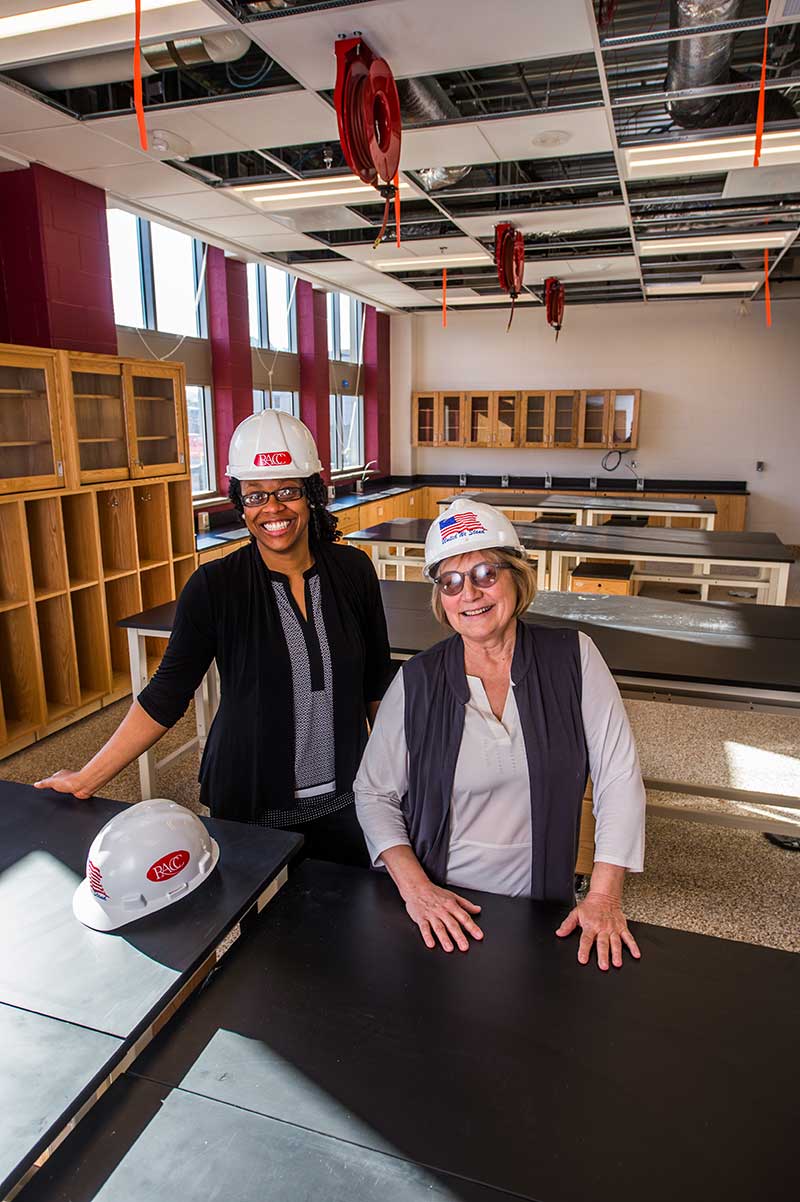
RACC
New Labs Prepare RACC STEM Students for Jobs of the Future
Nanoscience Coordinator and Biology Professor Kathy McCann Evans’ fifth floor biology lab in Berks Hall on the Reading Area Community College (RACC) campus was furnished with vintage laboratory equipment and furnishings –long black benches paneled and patched in dark orange or mustard yellow, low, obstructive ventilation hoods and uneven metal equipment storage shelves.
To adults visiting the labs, they looked exactly like the labs they had in high school or college, and that’s the problem. “I have been here since these labs were built in 1976, and since then, they have operated every hour of every day, of every week, of every semester…and they were just plumb done,” says McCann Evans.
RACC leadership agreed with McCann Evans, and in early 2017 the Science of Success Campaign began. The Campaign goal is to raise $2 million in charitable contributions to support renovations to and the expansion of the College’s science laboratories. The initiative, for which construction commenced in December of 2016, has a total budget of $4.5 million.
The science lab renovation project allows for the complete renovation of the existing labs in Berks Hall, which will result in state-of-the-art biology and anatomy labs and the relocation of the chemistry and physics labs to the Schmidt Training and Technology Center (STTC). The Science of Success campaign will benefit the majority of degree track students at RACC, greatly enhancing science and technical education for career pathways leading to a pipeline of highly-skilled employees.
With this flexible/multi-use approach, RACC will enhance its ability to support students in science, technology, advanced manufacturing, engineering/mechatronics-related and healthcare occupations.
Beyond RACC
The new labs are also of importance to local employers. The labs will be easily reconfigured to provide specialized training spaces on-demand, allowing the College to create new educational pathways for the next generation of smart energy systems technicians, automated food production and analysis technicians, and various applied engineering technicians. Technology and manufacturing employers will be able to utilize these spaces to provide training programs for their workers.
Anticipation of the opportunities created by the new labs continues to generate excitement among RACC faculty and officials: “Most colleges approach renovations and expansions of science laboratories solely to meet academic needs; RACC is proud to approach this project in a creative way that expands the value of this expenditure to create learning spaces that will also improve the knowledge and skills of the workforce,” says Dr. Anna Weitz, president of Reading Area Community College.
Gloria Oikelome, RACC Assistant Dean of the Division of Science and Mathematics, adds, “The Laboratory courses are an integral part of the undergraduate curriculum in any science program. Science instructors all agree that the laboratory is an essential component of the learning experience. Our students and teachers have worked with what they have and have done their best to bring it alive, but they were limited. The new labs are going to help students get excited about science, which is what we need.”
Kathy McCann Evans concludes, “The success stories that come out of this school are amazing, especially for us, the ones in science…we take it personally. Because to us, we’re more like a family than an institution.”








